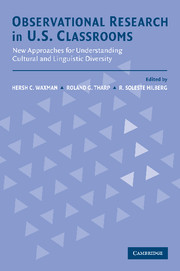 Observational Research in U.S. Classrooms
Observational Research in U.S. Classrooms Book contents
- Frontmatter
- Contents
- Tables, Figures, and Appendixes
- Contributors
- 1 Introduction: Purposes and Perspectives on Classroom Observation Research
- 2 Using Multiple Perspectives in Observations of Diverse Classrooms: The Sheltered Instruction Observation Protocol (SIPO)
- 3 The Standards Performance Continuum: A Performance-Based Measure of the Standards for Effective Pedagogy
- 4 The Uses of the Classroom Observation Schedule to Improve Classroom Instruction
- 5 Development and Use of a Classroom Observation Instrument to Investigate Teaching for Meaning in Diverse Classrooms
- 6 Patterns of Language Arts Instructional Activity and Excellence in First– and Fourth–Grade Culturally and Linguistically Diverse Classrooms
- 7 Using Classroom Observation as a Research and Formative Evaluation Tool in Educational Reform: The School Observation Measure
- 8 Observing School Restructuring in Multilingual, Multicultural Classrooms: Balancing Ethnographic and Evaluative Approaches
- 9 Sociocultural Activity Settings in the Classroom: A Study of a Classroom Observation System
- 10 The Influence of School Reform on Classroom Instruction in Diverse Schools: Findings from an Observational Study of Success for All
- 11 Future Directions for Classroom Observation Research
- Index
- References
9 - Sociocultural Activity Settings in the Classroom: A Study of a Classroom Observation System
Published online by Cambridge University Press: 23 November 2009
- Frontmatter
- Contents
- Tables, Figures, and Appendixes
- Contributors
- 1 Introduction: Purposes and Perspectives on Classroom Observation Research
- 2 Using Multiple Perspectives in Observations of Diverse Classrooms: The Sheltered Instruction Observation Protocol (SIPO)
- 3 The Standards Performance Continuum: A Performance-Based Measure of the Standards for Effective Pedagogy
- 4 The Uses of the Classroom Observation Schedule to Improve Classroom Instruction
- 5 Development and Use of a Classroom Observation Instrument to Investigate Teaching for Meaning in Diverse Classrooms
- 6 Patterns of Language Arts Instructional Activity and Excellence in First– and Fourth–Grade Culturally and Linguistically Diverse Classrooms
- 7 Using Classroom Observation as a Research and Formative Evaluation Tool in Educational Reform: The School Observation Measure
- 8 Observing School Restructuring in Multilingual, Multicultural Classrooms: Balancing Ethnographic and Evaluative Approaches
- 9 Sociocultural Activity Settings in the Classroom: A Study of a Classroom Observation System
- 10 The Influence of School Reform on Classroom Instruction in Diverse Schools: Findings from an Observational Study of Success for All
- 11 Future Directions for Classroom Observation Research
- Index
- References
Summary
This chapter reports on the theoretical conceptualization, development, and measurement properties of an observation instrument for coding classroom instructional activities. This required the examination of several fundamental issues concerning sociocultural theory as it relates to schooling. These issues are presented through a discussion of the relationships between theory, method, and analysis used in the development of a training program for observing, analyzing, and quantifying classroom activities.
In the past two decades, we have seen many treatments of activity theory in the field of education. From the sociocultural perspective, many interesting and useful constructs have been proposed to capitalize on these ideas. However, the accumulation of empirical research has been retarded by the lack of suitable quantifying instruments. In our view, as important as all these ideas are in the field of education, they serve no one well if they don't promote active empirical research.
Most of the critical data in sociocultural theory have been qualitative, and many have been thick ethnographic and discourse analytic descriptions. Critics of sociocultural theory often object to the lack of objective, quantifiable methods that are more typical of sociologists and psychologists. In particular, much work on activity theory in education has relied on thick observation, but applications in real educational settings have been minimal because there are no instruments for broader use that allow for more studies of a different kind. Sociocultural theorists have asked: Can a thin system for observing and quantifying sociocultural activities be developed?
- Type
- Chapter
- Information
- Observational Research in U.S. ClassroomsNew Approaches for Understanding Cultural and Linguistic Diversity, pp. 205 - 230Publisher: Cambridge University PressPrint publication year: 2004
References
- 4
- Cited by


